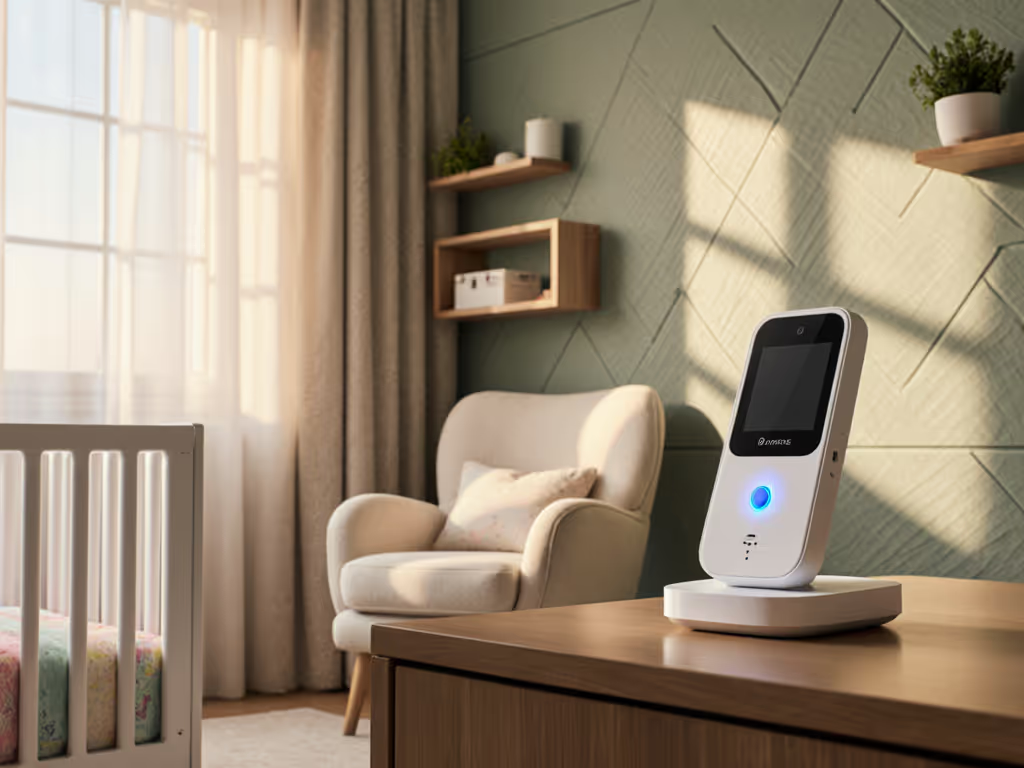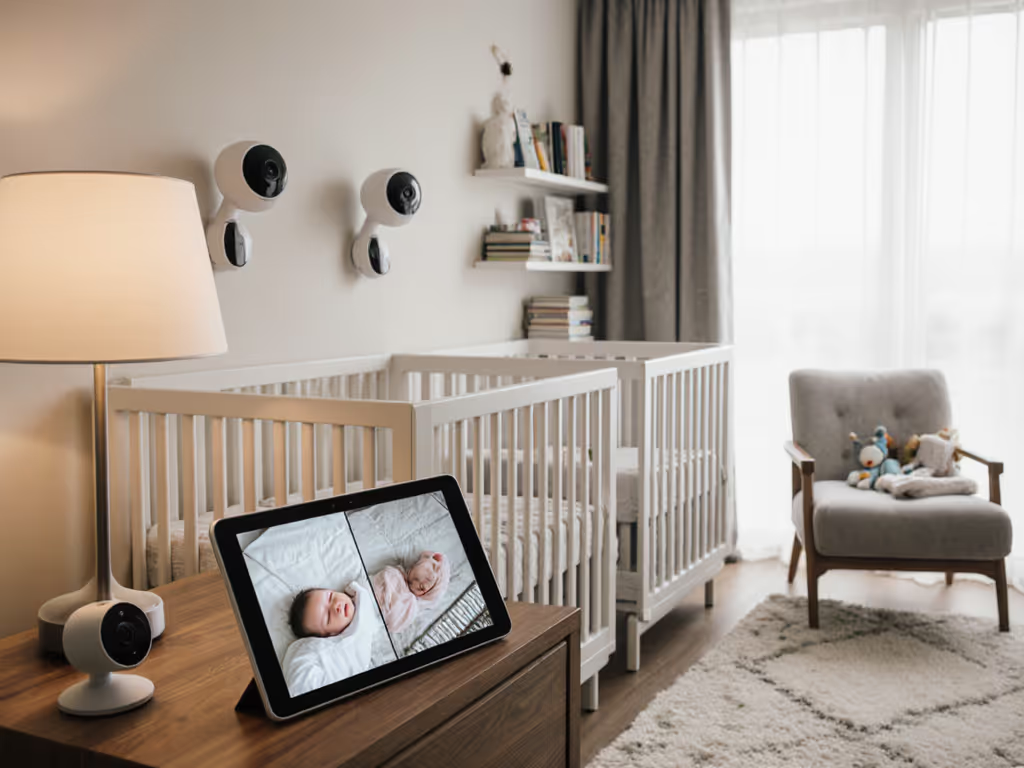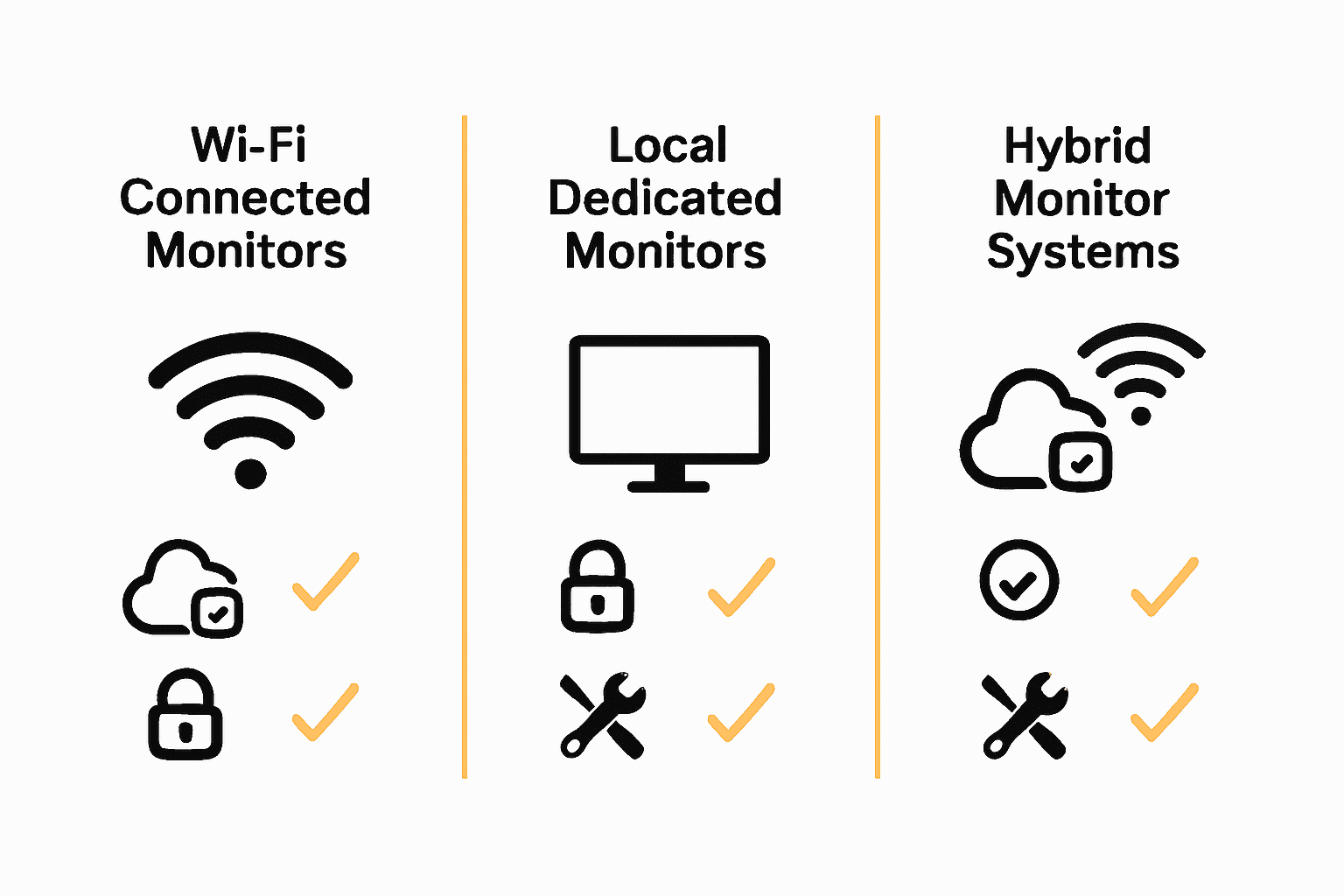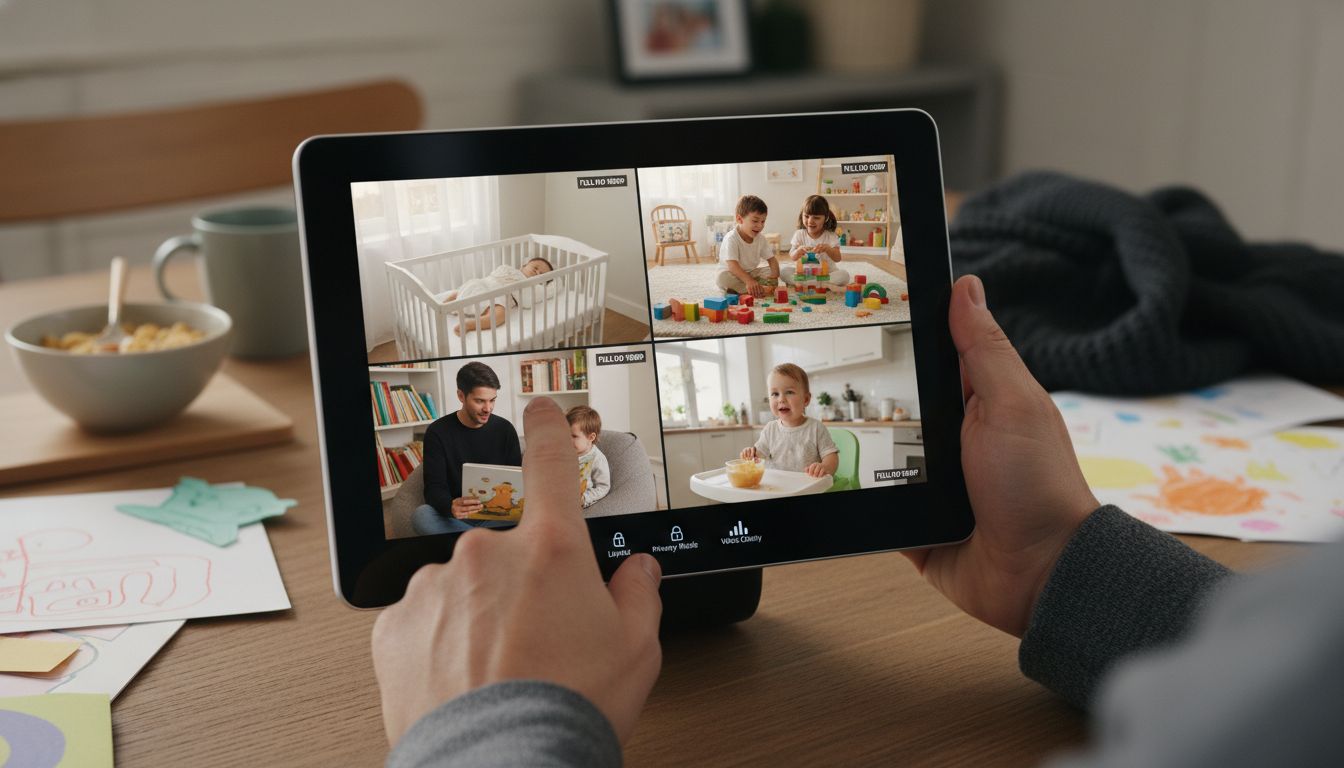
Split Screen Baby Monitors: Complete Guide for Parents

Over 60 percent of families with more than one child admit that keeping track of everyone feels impossible at times. As children move between rooms, play, and nap in different spaces, parents often wish they could be in two places at once. A split screen baby monitor bridges that gap by letting you watch multiple cameras on one screen, so you can check in on your nursery and toddler’s room at the same time—helping you stay connected, confident, and one step ahead.
Key Takeaways
| Point | Details |
|---|---|
| Enhanced Monitoring | Split screen baby monitors provide simultaneous viewing of multiple camera feeds for better oversight of children. |
| Privacy Options | Options include Wi-Fi connected monitors for remote access or local dedicated monitors for enhanced security. |
| Flexibility | Hybrid systems allow switching between internet and local monitoring modes to suit family needs. |
| Advanced Features | Modern monitors come equipped with motion detection, two-way audio, and temperature monitoring for comprehensive care. |
What Is a Split Screen Baby Monitor?
A split screen baby monitor is a game-changing parenting technology that transforms how we watch over our little ones. Unlike traditional single-camera monitors, these advanced devices allow parents to view multiple camera feeds simultaneously on one display, giving you a comprehensive view of your children's spaces without constant room-hopping.
At its core, a split screen baby monitor provides real-time visual monitoring across different rooms or for multiple children. Imagine watching your newborn in the nursery while simultaneously keeping an eye on your toddler playing in their bedroom - all from a single screen. This technology is particularly useful for parents of twins, those with children in separate rooms, or families with multiple young children who require constant supervision.
The key features of split screen baby monitors typically include:
- Simultaneous multi-camera viewing
- High-resolution video feeds
- Real-time audio monitoring
- Ability to zoom or pan individual camera views
- Night vision capabilities
- Temperature monitoring
While some split screen monitors require Wi-Fi connectivity, others offer local monitoring options, providing flexibility for parents concerned about digital privacy. The technology essentially creates a personal surveillance system tailored specifically to your family's unique monitoring needs. Whether you're a first-time parent or managing multiple children, these monitors offer peace of mind through comprehensive, convenient surveillance.
Modern split screen baby monitors go beyond simple video transmission. They integrate advanced technologies like motion detection, two-way audio communication, and even smartphone app connectivity. This means you can not only see your children but also interact with them, soothe them remotely, and receive instant alerts about any unusual activity or environmental changes.
Types of Split Screen Baby Monitors Explained
Split screen baby monitors have evolved into several distinct categories, each designed to meet different parental monitoring needs and technological preferences. Understanding these types can help you choose the most suitable solution for your family's unique circumstances.
Wi-Fi Connected Monitors
Wi-Fi connected split screen monitors represent the most technologically advanced category. These systems allow parents to access camera feeds through smartphone apps, providing remote monitoring capabilities from anywhere with an internet connection. Key advantages include:
- Real-time streaming to multiple devices
- Cloud storage of video recordings
- Smartphone app integration
- Remote zoom and camera control
- Instant notifications for sound or movement
Local Dedicated Monitors
Traditional local dedicated monitors operate without internet connectivity, using a direct signal between cameras and a handheld receiver. These monitors prioritize privacy and reliability, offering several benefits:
- No dependency on Wi-Fi networks
- Lower potential for digital security risks
- Consistent signal within home range
- Typically longer battery life
- More affordable initial investment
Hybrid Monitor Systems
Hybrid split screen monitors combine the best features of Wi-Fi and local monitoring technologies. These versatile systems offer parents maximum flexibility, allowing switching between local and internet-based monitoring modes. They're particularly useful for families wanting comprehensive monitoring options without compromising privacy.
Here's a comparison of the main types of split screen baby monitors:
| Feature | Wi-Fi Connected Monitors | Local Dedicated Monitors | Hybrid Monitor Systems |
|---|---|---|---|
| Connectivity | Internet/Wi-Fi | Direct RF (no internet) | Both Wi-Fi and RF |
| Remote Access | Yes, via app | No | Yes, with option to disable |
| Privacy/Security | Depends on network setup | High privacy | Customizable privacy settings |
| Video Storage | Cloud storage available | Limited/local only | Cloud & local optional |
| Notifications/Alerts | Instant, app-based | Basic/local only | Both app and local |
| Price Range | Moderate to high | Usually more affordable | Varies (mid to high) |
| Setup Complexity | Higher, needs home Wi-Fi | Easy, out-of-the-box | Moderate, supports both modes |
The choice between these monitor types depends on individual family preferences, home network stability, privacy concerns, and specific monitoring requirements. Each type offers unique advantages, ensuring parents can find a solution that matches their exact needs and technological comfort level.

Key Features and How Split Screen Works
A split screen baby monitor transforms your parenting experience by creating a comprehensive visual ecosystem that lets you monitor multiple spaces simultaneously. The core functionality revolves around displaying multiple camera feeds on a single screen, allowing you to keep a watchful eye on different rooms or children without constantly switching views.
Display Customization
Split screen monitors offer remarkable flexibility in how you view camera feeds. Parents can typically choose from various display layouts:

- Side-by-side view (two cameras)
- Four-camera grid layout
- Prioritized main screen with smaller secondary views
- Customizable screen division percentages
- Quick camera rotation and switching
Technical Mechanism
The technical magic behind split screen functionality involves sophisticated signal processing and display technologies. Local monitors use direct radio frequency (RF) transmission between cameras and the receiver, while Wi-Fi enabled systems leverage internet protocols to stream multiple video feeds concurrently. Each camera is synchronized to broadcast its feed simultaneously, allowing seamless real-time monitoring.
Advanced Monitoring Features
Beyond basic visual monitoring, modern split screen baby monitors integrate multiple advanced technologies:
- Motion detection that triggers instant alerts
- Two-way audio communication
- Room temperature tracking
- Sound level indicators
- Infrared night vision capabilities
These intelligent systems do more than just show video. They create a comprehensive monitoring environment that adapts to your family's specific needs, providing peace of mind through technology that understands the complexities of childcare.
Benefits for Multi-Child and Multi-Room Families
For families juggling multiple children or navigating complex household dynamics, split screen baby monitors emerge as an absolute game-changer. These sophisticated monitoring systems provide unprecedented visibility across different rooms and spaces, transforming how parents manage simultaneous childcare responsibilities.
Comprehensive Monitoring Strategies
Split screen technology addresses the unique challenges faced by families with multiple children or complex living arrangements. Parents of twins, siblings with different sleep schedules, or families with children in separate rooms can now maintain real-time visual contact without constant physical movement. The ability to monitor multiple spaces simultaneously reduces parental stress and enhances overall household management.
Key advantages for multi-child families include:
- Simultaneous visual monitoring of different rooms
- Reduced need for constant physical room checks
- Enhanced safety through comprehensive coverage
- Individual camera customization
- Ability to track multiple children's activities
Practical Household Applications
Beyond basic monitoring, these systems offer strategic benefits for diverse family configurations. Whether you have an infant in the nursery, a toddler in a playroom, or children with different sleep patterns, split screen monitors provide a holistic view of your household. The technology adapts to your family's unique layout, offering customizable views that prioritize your specific monitoring needs.
Moreover, split screen baby monitors help working parents or caregivers maintain a sense of connection and security. By providing real-time, multi-room visibility, these devices offer peace of mind and practical support. They essentially become an extra set of eyes, helping parents manage complex household dynamics with greater ease and confidence.
Privacy, Security, and Common Concerns
When it comes to baby monitors, privacy and security aren't just technical considerations—they're fundamental parental priorities. Parents rightfully want a monitoring system that protects their family's most intimate moments while providing reliable, secure surveillance of their children.
Digital Privacy Risks
Modern split screen baby monitors present a complex landscape of potential privacy challenges. Wi-Fi connected systems, while convenient, can potentially expose families to digital vulnerabilities. Hackers might exploit weak network configurations or unsecured transmission protocols to gain unauthorized access to video feeds. These risks make many parents hesitant about internet-connected monitoring solutions.
Key privacy vulnerabilities include:
- Unsecured wireless network transmission
- Weak device encryption
- Potential smartphone app data breaches
- Unprotected cloud storage
- Inadequate password protection
Local Monitoring Solutions
To address these concerns, many manufacturers now offer local monitoring systems that eliminate internet-based risks. These devices use direct, encrypted radio frequency signals between cameras and receivers, ensuring that video feeds remain completely private and inaccessible to external networks. By keeping all monitoring data within a closed, secure system, parents can feel confident about their children's privacy.
Beyond technological safeguards, parents should also implement personal security practices. This includes regularly updating device firmware, using strong unique passwords, and being mindful of device placement to prevent unauthorized visual access. The goal is creating a monitoring environment that prioritizes both technological protection and thoughtful, privacy-conscious decision-making.
Comparing Split Screen to Single-Camera Alternatives
Choosing the right baby monitoring technology is more than just a purchasing decision—it's about creating a comprehensive safety ecosystem for your family. Split screen monitors represent a significant leap forward from traditional single-camera alternatives, offering parents unprecedented visibility and control.
Functionality Differences
Single-camera monitors force parents into a reactive monitoring mode, requiring manual switching between different views or rooms. In contrast, split screen monitors provide simultaneous, comprehensive coverage. Imagine trying to monitor a sleeping infant while keeping an eye on a toddler playing in another room—with a single-camera system, you're constantly toggling between feeds, creating moments of potential oversight.
Key comparative advantages include:
- Simultaneous multi-room monitoring
- Reduced manual camera switching
- Enhanced real-time visibility
- More comprehensive child tracking
- Improved situational awareness
Cost and Complexity Considerations
While split screen monitors typically represent a higher initial investment compared to single-camera systems, they deliver substantial long-term value. The additional cameras and advanced display technologies mean parents gain a more sophisticated monitoring solution. For families with multiple children or complex living spaces, the extra expense translates directly into improved peace of mind and practical household management.
Ultimately, the choice between single-camera and split screen monitors depends on your specific family dynamics. For parents of multiple children, those with larger homes, or families needing comprehensive monitoring, split screen technology isn't just an upgrade—it's a transformative approach to child supervision that provides unparalleled visibility and security.
Discover the Perfect Split Screen Baby Monitor for Your Family
Managing multiple camera feeds and ensuring privacy can feel overwhelming when choosing a split screen baby monitor. You want clear simultaneous views across rooms without worrying about complicated setups or security risks. The challenge is balancing high-tech features like motion detection and two-way audio with simple, secure operation that fits your household needs.
At babymonitorsforparents.pro, we understand your concerns about privacy and the desire for reliable, easy-to-use split screen monitors. Our expert guides and in-depth reviews highlight models with trusted local monitoring options and Wi-Fi connectivity that keep your family safe and sound. Learn about practical setup tips and compare key features like zoom capabilities and sound alerts designed specifically for multi-child and multi-room families.
Ready to take control and find the best split screen baby monitor tailored for your home environment? Visit babymonitorsforparents.pro now to explore trusted advice and make a confident choice so you can enjoy peace of mind today.
Frequently Asked Questions
What is a split screen baby monitor?
A split screen baby monitor is a parenting device that allows you to view multiple camera feeds simultaneously on one display, enabling comprehensive monitoring of different rooms or multiple children.
What are the key features of split screen baby monitors?
Key features typically include simultaneous multi-camera viewing, high-resolution video feeds, real-time audio monitoring, zoom or pan capabilities, night vision, and temperature monitoring.
What are the main types of split screen baby monitors?
The main types are Wi-Fi connected monitors, which offer remote access via smartphone apps; local dedicated monitors, which operate without internet; and hybrid systems, which combine both local and internet functionalities for maximum flexibility.
How do I ensure the privacy and security of my split screen baby monitor?
To enhance privacy, consider using local dedicated monitors that don't rely on the internet. Additionally, regularly update device firmware, use strong passwords, and ensure your wireless network is secure to protect against potential vulnerabilities.




